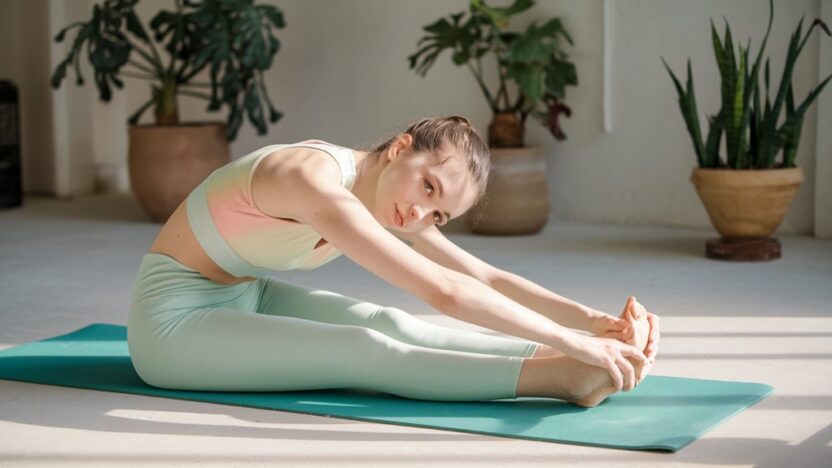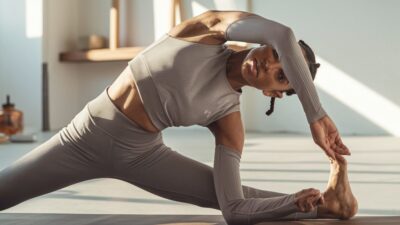Getting started with flexibility exercises is easier than you think, and you'll feel the benefits throughout your daily activities. Begin by warming up your muscles with 5-10 minutes of light cardio, like walking or arm circles. Focus on gentle stretches for your neck, shoulders, back, and lower body, holding each position for 15-30 seconds while breathing deeply. Don't bounce or force movements, and always stop if you feel sharp pain. Remember to stretch both sides of your body equally and maintain proper form for the best results. There's much more to discover about enhancing your flexibility safely and effectively.
Why Flexibility Matters
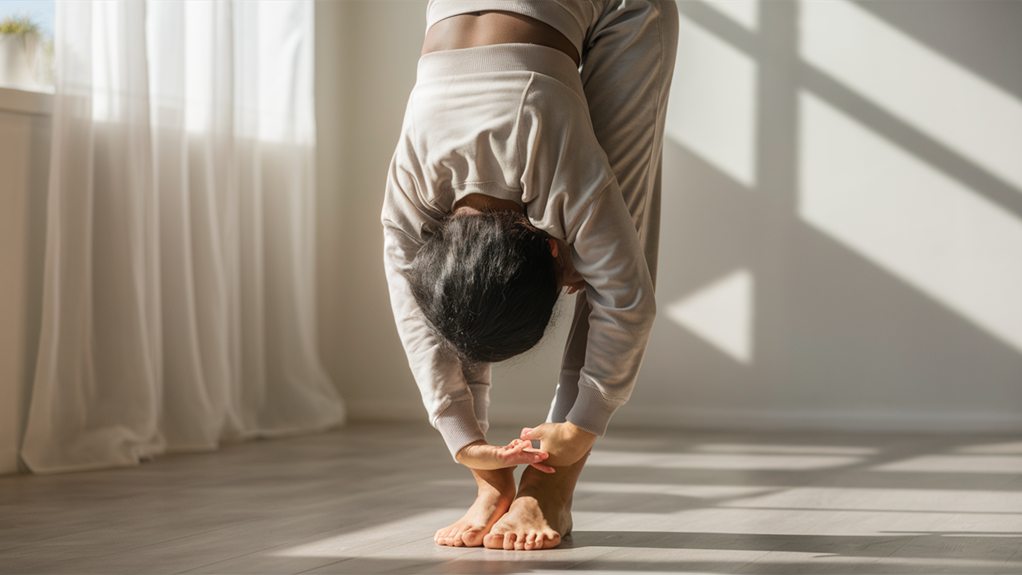
Body flexibility plays an important role in your overall fitness and daily life. When you're just starting flexibility workouts, you'll quickly notice how better range of motion helps with everyday tasks, from reaching high shelves to tying your shoes. Your body's ability to move freely doesn't just make daily activities easier, it also helps prevent injuries and reduces muscle tension.
Understanding the distinction between flexibility and mobility can further enhance your training, as both are vital for ideal movement and performance how each contributes to health.
As you begin basic flexibility routines, you'll discover that improved flexibility leads to better posture, which can relieve back pain and help you feel more confident. Whether you're an office worker who sits all day or someone who's active, flexibility exercises for beginners can greatly reduce your risk of muscle strains and joint problems.
You'll find that regular stretching helps your muscles recover faster after workouts, decreases stress levels, and improves your athletic performance.
Your body's flexibility directly affects how well you'll age, too. By maintaining good flexibility now, you're investing in your future mobility and independence.
Think of flexibility training as important maintenance for your body's joints and muscles, helping you move more smoothly through life's physical demands.
Basic Stretching Safety Guidelines
Now that you understand why flexibility matters, let's focus on safe stretching practices to prevent injury. When starting flexibility training for beginners, it's essential to follow proper guidelines to make your stretching routine both effective and safe.
Incorporating quick stretches throughout your day, like during breaks at work, can greatly contribute to your overall flexibility incorporate flexibility exercises.
Always warm up your muscles before stretching by walking or doing light cardio for 5-10 minutes, as cold muscles are more prone to injury.
When you're stretching, don't bounce or force your body beyond its natural range of motion, as this can lead to muscle strain or tears. You'll want to hold each stretch for 15-30 seconds while breathing deeply and naturally, allowing your muscles to gradually relax into the position.
If you feel sharp pain during any stretch, stop immediately, as pain is your body's warning signal. Remember to stretch both sides of your body equally, and don't rush through your routine.
It's also important to maintain proper form throughout each stretch, keeping your back straight and your movements controlled.
When you're done stretching, shift slowly back to regular movement to give your body time to adjust.
Neck and Shoulder Stretches
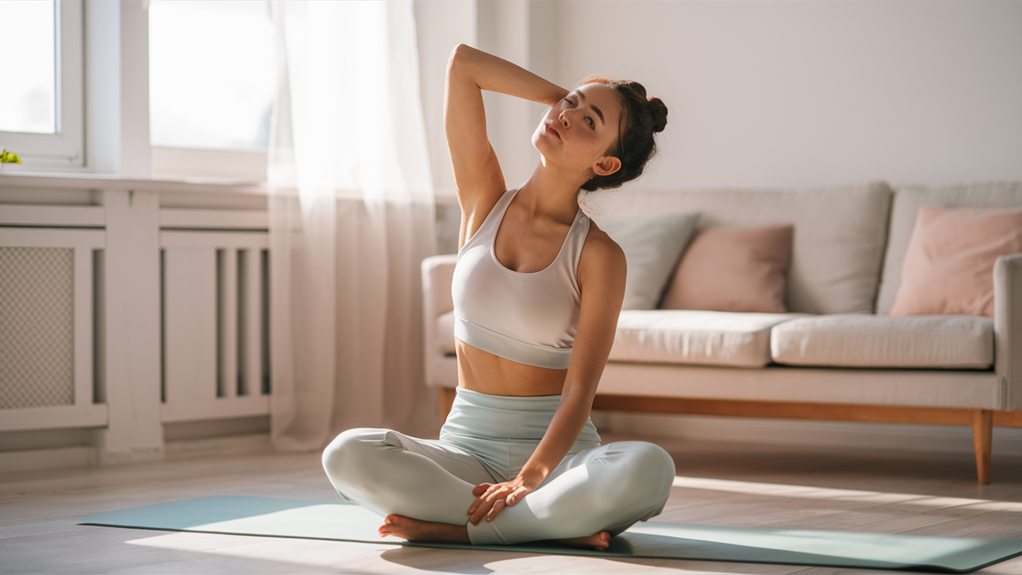
Tension-filled neck and shoulder muscles are often the first areas that need attention in a flexibility routine. Throughout your day, these muscles can become stiff from looking at screens, carrying heavy bags, or dealing with stress, which is why it's crucial to give them proper care.
To guarantee you're also practicing safe movements during these stretches, consider incorporating injury prevention techniques into your routine.
Start with a gentle neck rotation, where you'll slowly roll your head in a circular motion, first clockwise and then counterclockwise. Next, try the upper trapezius stretch by gently tilting your head toward one shoulder until you feel a stretch along the side of your neck, holding for 15-20 seconds on each side.
For your shoulders, you can perform shoulder rolls, moving them forward and backward in controlled circles. A great shoulder blade stretch involves clasping your hands behind your back and lifting them away from your body while keeping your arms straight.
Don't forget the cross-body shoulder stretch, where you'll bring one arm across your chest and use your other arm to hold it in place. Remember to breathe deeply during each stretch, and if you feel any pain, ease off immediately.
Back Mobility Exercises
Back Mobility Exercises
After addressing your neck and shoulders, maintaining a healthy spine becomes the next essential focus in your flexibility journey. Your back needs regular movement to stay mobile and pain-free, and there are several effective exercises you can try right at home.
Incorporating strength training into your routine can complement these flexibility exercises, helping to enhance muscle support around the spine and improve overall stability age-appropriate strength training recommendations.
Start with the cat-cow stretch, where you'll position yourself on your hands and knees, alternating between arching and rounding your back. This gentle movement helps warm up your entire spine and releases tension in your lower back muscles.
Next, try the child's pose, which you'll perform by sitting back on your heels and reaching your arms forward, letting your chest sink toward the ground.
For a deeper stretch, the seated spinal twist is excellent, and you'll perform it by sitting with your legs extended, crossing one leg over the other, and gently rotating your torso.
Remember to breathe deeply as you hold each position for 15-30 seconds, and don't force any movements that cause discomfort.
These exercises will improve your spinal mobility, reduce stiffness, and help prevent future back problems when practiced regularly.
Lower Body Flexibility Routine
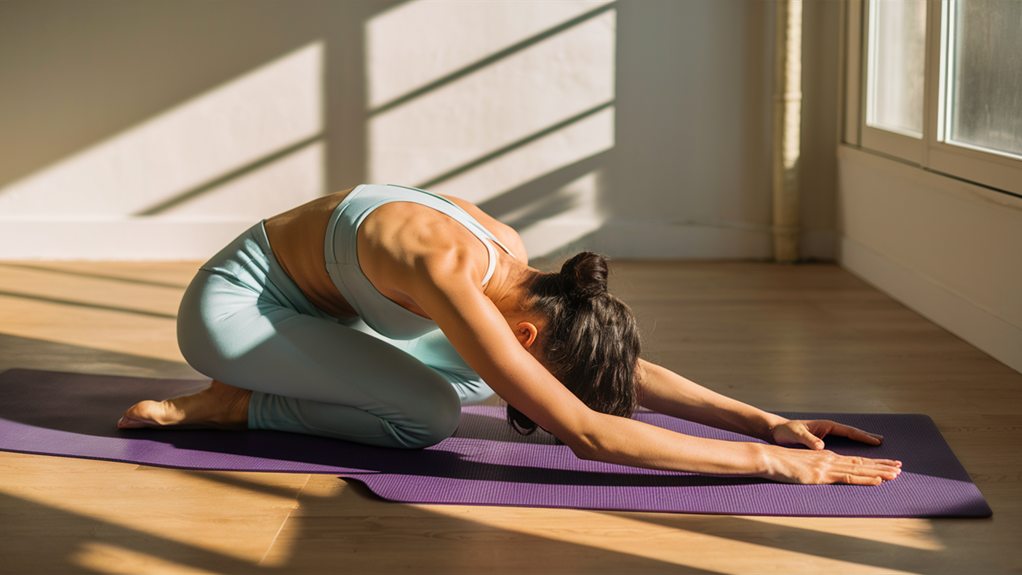
A well-rounded flexibility routine can't overlook your lower body, where many people hold the most tightness. Your legs, hips, and glutes work hard every day, and they'll benefit greatly from regular stretching to maintain their range of motion and prevent stiffness.
Maintaining flexibility is essential as we age, as it promotes better joint health and overall mobility, which can greatly enhance your quality of life embrace movement.
Start your lower body routine with gentle hip circles, moving your hips in a circular motion while standing. Then, perform forward folds to stretch your hamstrings, keeping your knees slightly bent to avoid strain.
Next, try the figure-four stretch, where you'll cross one ankle over your opposite thigh while sitting, to target your hip muscles and glutes. For your calves and ankles, you'll want to do standing wall stretches, pressing your hands against a wall while extending one leg behind you.
Don't forget to include lunges in your routine, which help stretch your hip flexors and quadriceps. Hold each stretch for 20-30 seconds, breathing deeply and never bouncing or forcing the movement.
You'll feel the most benefit when you're consistent, so aim to perform these stretches at least three times per week.
Common Stretching Mistakes
Many beginners unknowingly develop poor stretching habits that can limit their progress or even lead to injury. When you're just starting your flexibility journey, it's essential to understand what not to do during your stretching routine, as proper form and technique will help you achieve better results while staying safe.
It's a common misconception that stretching can prevent all injuries, but it's important to know that flexibility training is just one part of a thorough injury prevention strategy busting myths about flexibility.
Here are the most common mistakes you'll want to avoid:
- Bouncing during stretches, which can cause muscle tears and strain, instead of holding your stretches steadily for 15-30 seconds.
- Stretching cold muscles without a proper warm-up, when your body needs at least 5-10 minutes of light cardio to increase blood flow.
- Pushing too hard and stretching to the point of pain, rather than maintaining a gentle stretch that feels challenging but comfortable.
- Holding your breath while stretching, which tenses your muscles, instead of maintaining steady, deep breaths throughout each stretch.
Remember that flexibility develops gradually, and you shouldn't try to force quick progress. By avoiding these common mistakes and focusing on proper technique, you'll create a foundation for safe and effective stretching practice.
Creating Your Daily Stretch Plan
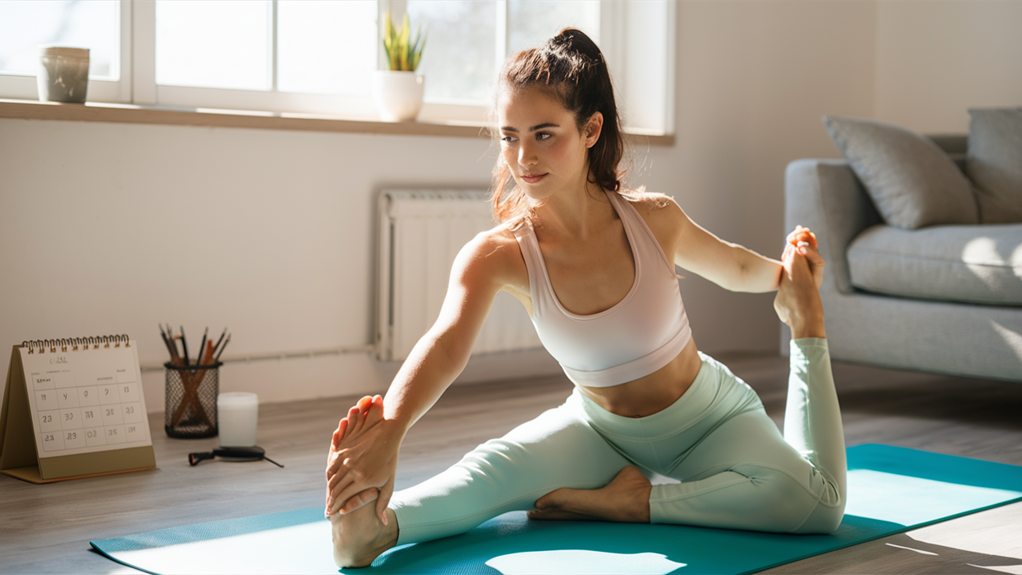
Now that you understand what not to do when stretching, you'll want to build a consistent routine that works for your schedule and goals. Start by choosing a time of day when you won't feel rushed, whether that's first thing in the morning or right before bed. You'll need about 15-20 minutes to complete a full-body stretching session.
Begin with a simple warm-up, like walking in place or arm circles, to get your blood flowing. Then, work your way through your stretches from head to toe, holding each position for 15-30 seconds. Focus on major muscle groups, including your neck, shoulders, back, hips, thighs, and calves.
You'll want to repeat each stretch 2-3 times for the best results. Make sure you're tracking your progress by writing down which stretches you do and how long you hold them. It's helpful to start with 3-4 stretches per body part and gradually add more as you become more flexible.
Remember to breathe deeply throughout your routine, and don't push yourself too hard too fast. Consistency is more important than intensity when you're just starting out.
Measuring Flexibility Progress
Tracking your flexibility gains requires more than just feeling the difference in your stretches. To truly understand your progress, you'll need to establish clear measurements and keep detailed records of your flexibility journey.
You can monitor your flexibility improvements through several reliable methods that don't require special equipment. Here are four essential ways to track your progress:
- Take weekly photos of your stretches, making sure to use the same position and angle each time, which will give you a visual record of your improvements.
- Measure the distance between specific points during stretches, such as how far your fingertips are from the floor in a forward bend, using a simple tape measure.
- Time how long you can hold challenging positions, like splits or bridges, and record these durations in a stretching journal.
- Use joint angle measurements by recording the degrees of motion in key areas, such as how far you can lift your leg in a hamstring stretch.
Don't forget to note any discomfort or limitations you experience, as these details will help you adjust your routine and prevent injuries.
